Archive for the 'Board Game Review' Category
Posted by James (admin) on 11th April 2014
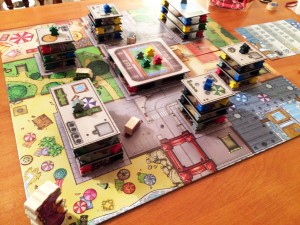 Rampage is a brilliant concept for a dexterity game. It’s like a Godzilla-style movie with tall buildings to destroy and people to eat. The board is divided into several coloured areas called neighbourhoods, and the player with the most Victory Points (VPs) at game end wins.
Rampage is a brilliant concept for a dexterity game. It’s like a Godzilla-style movie with tall buildings to destroy and people to eat. The board is divided into several coloured areas called neighbourhoods, and the player with the most Victory Points (VPs) at game end wins.
Rampage may sound kind of normal so far for a board game but it is anything but that as the gameplay is actually based on physically destroying the city. Each turn, your monster get 2 actions. To move your monster, you flick the feet disc. To attack buildings, take your monster piece and drop it onto a building (if you’re near enough). To use your breathe attack, place your chin on your monster piece and blow. To throw a vehicle, place the vehicle piece on top of your monster and flick it. Monsters can attack anything including each other and a successful attack removes one of their teeth. After their actions, your monster eats meeple out in the open in their current neighbourhood but no more than the number of teeth they have.
Buildings consist of layers of card floors separated by meeple of random colours. You want to knock these buildings down so you can (potentially) eat the meeple but you also take any floor sections which have nothing on them as these are worth VPs too. Read the rest of this entry »
Tags: board game news, Board Games, board gaming, Essen, Rampage, Repos Productions, Spiel 13, Spiel 2013
Posted in Board Game Review, Board Games, Essen Spiel 13, Rampage, Spiel 2013 | No Comments »
Posted by James (admin) on 10th April 2014
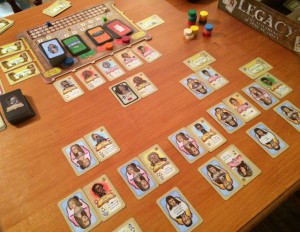
Legacy (or Legacy: Testament of Duke de Crecy to give it its full name) is a very innovative game where players try to create the most successful 18th century family starting with a single family member. Each round, players use their actions so that the current generation can get married, have children, buy mansions, start business ventures, arrange marriages for their children, etc. After a fixed number of rounds, the children grow up, any arranged marriages take place, and they become the current generation. Players then use actions for this new generation to get married, have children, etc. After the 3rd generation’s actions, the game ends and the player with the most points (Honour) wins.
Each player has an income track which earns cash each round, and a prestige track which earns Honour each generation. Players also earn Honour for having children, fulfilling objectives on their Patron card, fulfilling missions, as well as from friends marrying into the family, acquiring titles, etc. Plus, players must constantly manage their cash and friends – Friends are cards in a player’s hand each showing their sex, nationality, occupation, benefit when married into your family, and marriage cost (some generate cash as they come with a dowry). Read the rest of this entry »
Tags: board game news, Board Games, board gaming, Essen, Legacy, Portal Publishing, Spiel 13, Spiel 2013
Posted in Board Game Review, Board Games, Essen Spiel 13, Legacy, Spiel 2013 | 4 Comments »
Posted by James (admin) on 9th April 2014
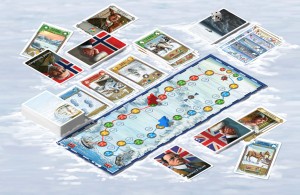 1911 Amundsen vs Scott is a simple, quick-moving, 2-player race to the South Pole which is full of small decisions. The game is based on the real events where Amundsen beat Scott to the Pole and Scott didn’t return.
1911 Amundsen vs Scott is a simple, quick-moving, 2-player race to the South Pole which is full of small decisions. The game is based on the real events where Amundsen beat Scott to the Pole and Scott didn’t return.
Players each have their own path of coloured spaces to move along and the first player to reach the South Pole wins. On their turn, a player draws 1-3 cards and can then play cards. When taking cards, you must draw the right-most (oldest) 1, 2 or 3 cards by discarding 0, 1 or 3 cards from your hand respectively. This can make for some interesting decisions because if you see cards you really want (or ones you don’t to deny your opponent) then you must decide whether it’s worth discarding cards you have to gain the new ones.
Almost all cards show one of 4 colours and many cards show one of the various special actions too (occurring when drawn, played or discarded). To move, you must play cards that match the colours of the next spaces along your path – 1 card for your next space, 2 cards for each space after that. This adds lots of fast card-management decisions to your game as you’re constantly trying to collect the mix of cards that will advance you and hinder your opponent. Many cards are both a colour and a type which adds some extra decisions to work out whether to use a card for its colour or its type (special effect). This is made slightly more tricky because you have a hand limit of 7 cards (and sometimes even fewer), plus the mix of cards you want changes rapidly as you and your opponent move. Read the rest of this entry »
Tags: 1911 Amundsen vs Scott, board game news, Board Games, board gaming, Essen, Spiel 13, Spiel 2013
Posted in 1911 Amundsen vs Scott, Board Game Review, Board Games, Essen Spiel 13, Spiel 2013 | No Comments »
Posted by James (admin) on 8th April 2014
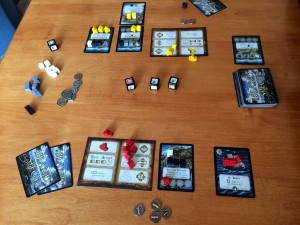 Island Siege caught my interest when it was a Kickstarter project but I only picked it up recently. A game for 2-players, it’s a card game at heart but feels bigger because the cards played stay on the table (well, until they’re blown to smithereens) and there are some very nice metal coins, a few wooden meeple and some dice too.
Island Siege caught my interest when it was a Kickstarter project but I only picked it up recently. A game for 2-players, it’s a card game at heart but feels bigger because the cards played stay on the table (well, until they’re blown to smithereens) and there are some very nice metal coins, a few wooden meeple and some dice too.
A player wins at the very start of their turn if all of the colonists on their Imperial card have been placed elsewhere or if they have 20+ coins. Each player starts with a fortress, a few cards in hand, and 9 colonists (meeple) on their Imperial card. Each turn, a player moves 1 colonist from their Imperial card onto each of their fortresses and then either:
- Draws 3 cards, keeping 2 and giving the other to their opponent
- Pays the relevant cost to build a card (fortress, ship or building) from their hand
- Attacks one of their opponent’s fortresses
Fortresses can be built for free, but adding extra building blocks (black/grey/white cubes) from your supply makes them stronger and earns coins. Buildings and ships can be built by moving enough colonists from a single fortress card to the building/ship card and this also earn coins. Buildings are added to a fortress giving it special abilities, but buildings are lost if the fortress they’re attached to is destroyed. Ships are independent, have special abilities and can also be destroyed.
Read the rest of this entry »
Tags: Ape Games, board game news, Board Games, board gaming, Island Siege
Posted in Board Game Review, Board Games, Island Siege | No Comments »
Posted by James (admin) on 4th April 2014
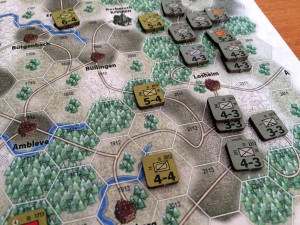 ‘Paul Koenig’s The Bulge: 6th Panzer Army’ (to use its full name) is a tactical, 2-player, World War II game with a hex map and counters. However, it packs a massive amount of decision-making into such a small area, and with relatively simple rules.
‘Paul Koenig’s The Bulge: 6th Panzer Army’ (to use its full name) is a tactical, 2-player, World War II game with a hex map and counters. However, it packs a massive amount of decision-making into such a small area, and with relatively simple rules.
One player plays the German army trying to break through the Allied lines by a surprise advance through the Ardennes forest (an event of major importance during the war), and the other player plays the Allies. This means the two sides are quite different – the Germans have lots of units but also have a lot of work to do as they need to advance to capture cities and get across the map; whereas, the Allied player has few units and needs to use these to hold up and disrupt the German advance.
The game ends after 7 turns when victory points (VPs) are assessed. The Germans score VPs for capturing cities and getting mechanised units (tanks, etc.) across to the far side of the map or, even better, beyond it. The Allies score VPs for cities not captured by the Germans. In addition, both sides score VPs for destroying units although the Allies score more for them, which balances up the other VPs the Germans can earn. When the game is over, the Allies win of they have at least 6 VPs more than the Germans (the Allies start with lots of VPs because no cities have been captured by the Germans yet). Read the rest of this entry »
Tags: 6th Panzer Army, Paul Koenig, Victory Point Games, VPG, WWII
Posted in 6th Panzer Army, Board Game Review, Board Games | 6 Comments »
Posted by James (admin) on 7th February 2014
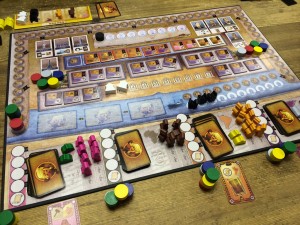 Artifact is a worker placement game with a difference as players place a common set of action markers which are limited in number and the cost of using them varies.
Artifact is a worker placement game with a difference as players place a common set of action markers which are limited in number and the cost of using them varies.
THE GAME
Players are archaeologists digging up artifacts, shipping them home and putting on exhibitions (after all, as Indy taught us, ‘they belong in a museum’). Players primarily score victory points (VPs) at game end by gaining museum exhibition tiles and having cash. The final round is triggered by one of 4 different events such as finishing the 8th round, when one deck of artifact cards runs out, etc.
Actions
During a round, players take turns performing either 1 or 2 actions. If a player passes, they can not perform any more normal actions that round (although they can perform a special action on their turn). All players start each round with 6 wooden action markers and there are 6 different types of these: ships, museums and 4 different colours of workers (one for each continent). The board has a track for each type of action marker and each space on these tracks shows a cost (going from from 5 down 1). Read the rest of this entry »
Tags: Artifact, Bernd Eisenstein, board game news, Board Games, board gaming, Essen, Jeffrey D Allers, Spiel 13, Spiel 2013, White Goblin Games
Posted in Artifact, Board Game Review, Board Games, Essen Spiel 13, Spiel 2013 | No Comments »
Posted by James (admin) on 30th January 2014
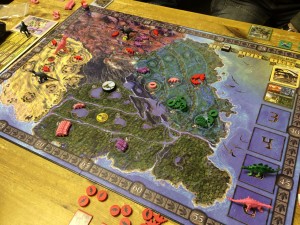 Triassic Terror is a dinosaur-themed, area control game by Peter Hawes – designer of Francis Drake (I will be reviewing this soon), Wars of the Roses and Heads of State.
Triassic Terror is a dinosaur-themed, area control game by Peter Hawes – designer of Francis Drake (I will be reviewing this soon), Wars of the Roses and Heads of State.
THE GAME
During the game, players try to dominate the landscape by growing their dinosaur herds and moving them from area to area. The board is split into 4 different terrains which are each split into 3 areas. There are 3 positions within each area – the largest herd in an area takes the best position, second largest takes the next one, and third largest takes the last one. If there’s a fourth herd in an area, it immediately dies – welcome to the harsh brutality of Triassic Terror.
The game lasts several rounds and Victory Points (VPs) are scored after each era (a group of rounds). VPs are scored based the on position a herd occupies in an area – each area scores slightly differently but the most VPs are always for the better positions (occupied by the biggest herd in the area). One side of the board is for 2-4 players, the other for 5-6 players – the difference being that the numbers of VPs scored are slightly different and all 3 positions in each area score in the 5-6 player game (rather than just the top two). Read the rest of this entry »
Tags: board game news, Board Games, board gaming, Essen, Spiel 13, Spiel 2013, Triassic Terror
Posted in Board Game Review, Board Games, Essen Spiel 13, Spiel 2013, Triassic Terror | No Comments »
Posted by James (admin) on 24th January 2014
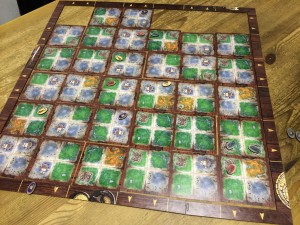
Old World New World is a fast-moving and simple game by Victory Point Games. The winner is the first player to get 3 of their units to the scoring locations on the furthest side of the board from where they start, and each player is heading in a different direction to the other players.
Gameplay is simple: At the start of the game, the board is blank – consisting of just the card frame – but this gets filled-in with landscape cards as the game progresses. Each card has 4 smaller squares on it showing land, sea or mountains – some land spaces have camps on them and some sea spaces have ports on them. On their turn, a player has a hand of cards and can take two actions. An action can be to place a card to fill in any empty square of the board, or they can discard a card to add new units, move existing units, or use a special card for its special effect.
There are a few important gameplay mechanics to mention. First, all players’ units are double-sided (soldiers and ships) – a player can move one of their soldier/ship units across land/sea by discarding a card showing a camp/port symbol respectively. Second, when you move a unit, you can move it as far as you want in a straight line so long as (a) the move is all on land (soldiers) or all on sea (ships), and (b) it doesn’t pass through any other unit. (Note that only soldiers units can only move into mountain spaces and must stop after 1 space). Third, a unit that is on a camp/port can perform a free move without using an action. Finally, a unit can be converted from a soldier unit into a ship unit if the unit is next to a port and the player plays a port card – this flips the unit over onto the adjacent space (and ships can be converted into soldiers in the same way using camps). Read the rest of this entry »
Tags: board game news, Board Games, board gaming, Old World New World, Victory Point Games
Posted in Board Game Review, Board Games, Old World New World | No Comments »
Posted by James (admin) on 23rd January 2014
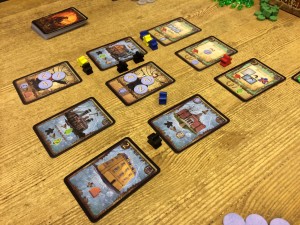 Spyrium is a eurogame with an interesting worker placement game mechanic. It is designed by the creator of Caylus and Caylus Magna Carta (the latter being one of my favourite games) so I was keen to try it out.
Spyrium is a eurogame with an interesting worker placement game mechanic. It is designed by the creator of Caylus and Caylus Magna Carta (the latter being one of my favourite games) so I was keen to try it out.
THE GAME
The game has a steampunk-ish setting and players are each head of an industrial conglomerate in Victorian England and spyrium is a mineral high in energy. The player who scores the most victory points (VPs) by the end of the game wins.
Each round 9 cards are drawn from the deck and laid out in a 3×3 grid – I’ll call this ‘the grid’ from now on. Players take turns either placing a worker or activating a worker; however, once a player starts activating their workers, they can’t return to placing workers during the current round. As a result, you have to choose carefully when to switch from placing to activating.
The cards in the 3×3 grid are either characters (one-off benefits that all players can use), buildings (which can be bought to give special actions), and patented techniques (which can be bought to give on-going abilities plus they score VPs at the end of the game too). When a building or technique is bought, it is removed from the grid and placed in front of its owner. Read the rest of this entry »
Tags: board game news, Board Games, board gaming, Caylus, Caylus Magna Carta, Essen, Spiel 2013, Spyrium
Posted in Board Game Review, Board Games, Essen Spiel 13, Spiel 2013, Spyrium | No Comments »
Posted by James (admin) on 21st January 2014
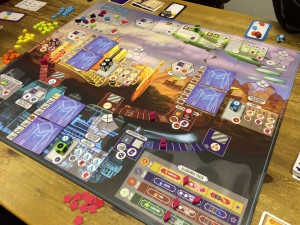 Set in a dystopian future, Euphoria is primarily a worker placement game, with lots of moving parts and a few new ideas. The winner is the first player to place all 10 of the authority tokens on the board and these can be placed in a variety of ways.
Set in a dystopian future, Euphoria is primarily a worker placement game, with lots of moving parts and a few new ideas. The winner is the first player to place all 10 of the authority tokens on the board and these can be placed in a variety of ways.
Players have workers (dice) which they place on the board to be able to earn commodities (food, water, energy, bliss) as well as resources (gold, stone, clay). The board shows a city divided into 4 main areas – each area belongs to a faction and each faction specialises in one of the commodities.
Euphoria is a gamer’s game. It’s not massively complicated but there are a lot of working parts to the game mechanics. Rather than try to explain the whole game, I’ll explain some of the main gameplay areas one-by-one to give the highlights.
WORKERS & PLACEMENT
On their turn, a player can place one of their workers (more if they have the same value – remember the workers are dice), or they can retrieve one or more of their workers from the board. All actions require a worker to be placed on the relevant location and most actions cost resources/commodities to use them. For many locations, a worker is returned to its owner if another worker is placed on the same location; for some other locations, multiple workers can be placed and the benefit earned is based on the total value of all the workers present; and for a few locations, only one worker can occupy the location.
Read the rest of this entry »
Tags: board game news, Board Games, board gaming, Euphoria
Posted in Board Game Review, Board Games, Euphoria | No Comments »
 Rampage is a brilliant concept for a dexterity game. It’s like a Godzilla-style movie with tall buildings to destroy and people to eat. The board is divided into several coloured areas called neighbourhoods, and the player with the most Victory Points (VPs) at game end wins.
Rampage is a brilliant concept for a dexterity game. It’s like a Godzilla-style movie with tall buildings to destroy and people to eat. The board is divided into several coloured areas called neighbourhoods, and the player with the most Victory Points (VPs) at game end wins.






 Triassic Terror is a dinosaur-themed, area control game by Peter Hawes – designer of Francis Drake (I will be reviewing this soon), Wars of the Roses and Heads of State.
Triassic Terror is a dinosaur-themed, area control game by Peter Hawes – designer of Francis Drake (I will be reviewing this soon), Wars of the Roses and Heads of State.

